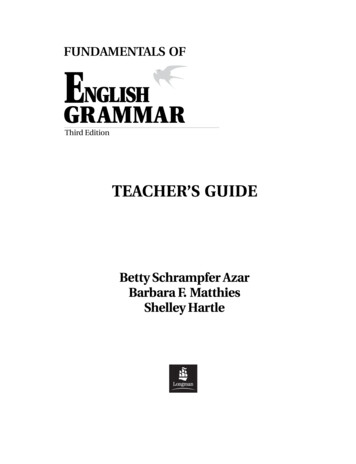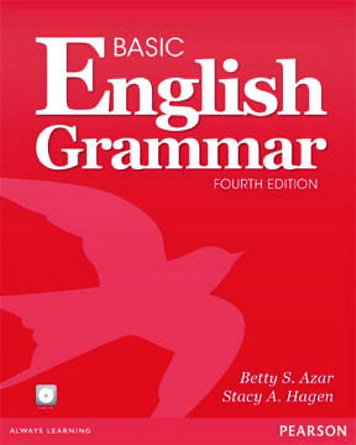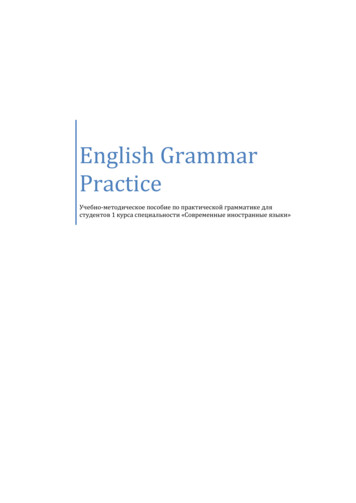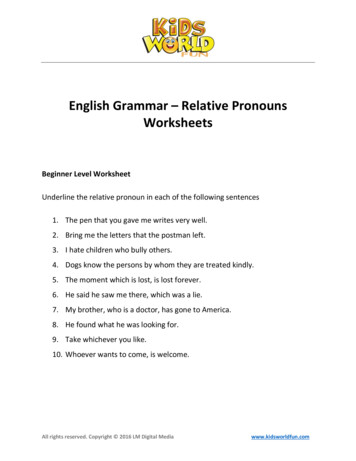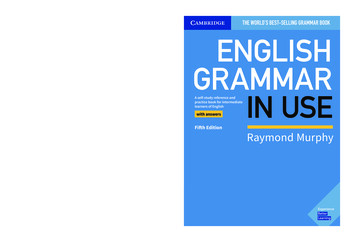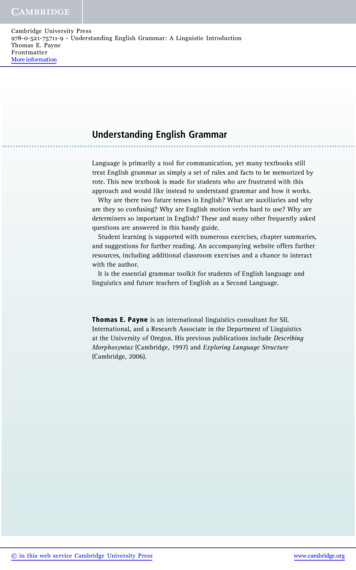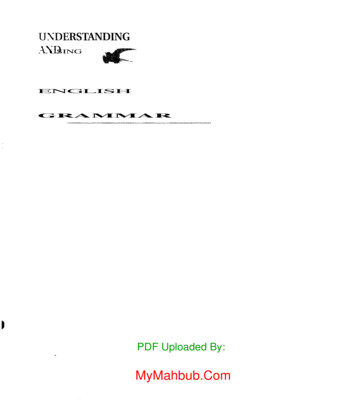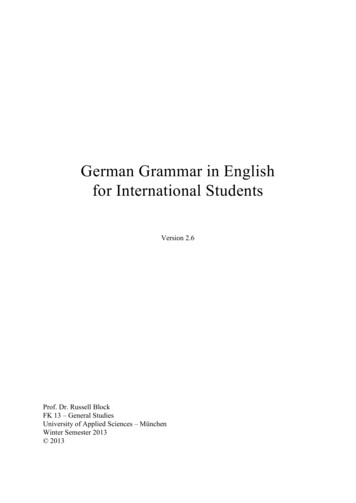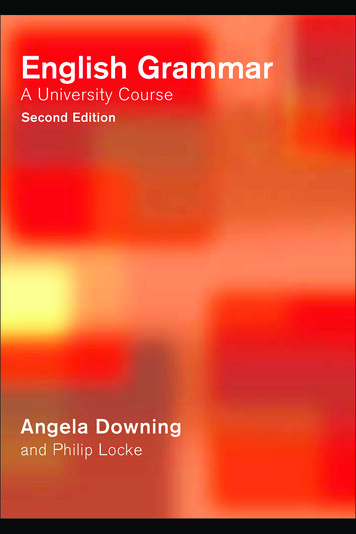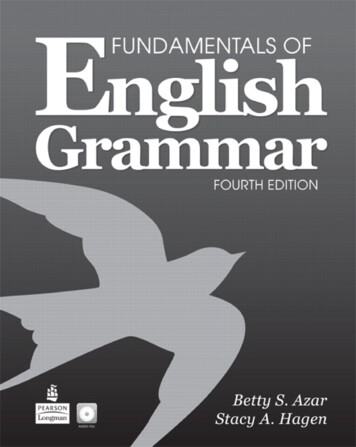
Transcription
A01 FEG SB 9326 FM.QXD1/3/118:00 AMPage inglishEGrammarFUNDAMENTALS OFFOURTH EDITIONBetty S. AzarStacy A. Hagen
A01 FEG SB 9326 FM.QXD1/3/118:00 AMPage vContentsContentsPreface to the Fourth Edition.xAcknowledgments . . . . . . . . . . . . . . . . . . . . . . . . . . . . . . . . . . . . . . . . . . . . . . . . . . . . . . . . xiiiChapter 1PRESENT TIME . . . . . . . . . . . . . . . . . . . . . . . . . . . . . . . . . . . . . . . . . . . . . . . . . . . 11-1 Simple present and present progressive . . . . . . . . . . . . . . . . . . . . . . . . . . . . . 31-2 Forms of the simple present and the present progressive . . . . . . . . . . . . . . . . 41-3 Frequency adverbs . . . . . . . . . . . . . . . . . . . . . . . . . . . . . . . . . . . . . . . . . . . 101-4 Singular/plural . . . . . . . . . . . . . . . . . . . . . . . . . . . . . . . . . . . . . . . . . . . . . . 131-5 Spelling of final -s/-es . . . . . . . . . . . . . . . . . . . . . . . . . . . . . . . . . . . . . . . . 141-6 Non-action verbs . . . . . . . . . . . . . . . . . . . . . . . . . . . . . . . . . . . . . . . . . . . . 171-7 Present verbs: short answers to yes/no questions . . . . . . . . . . . . . . . . . . . . . 20Chapter 2PAST TIME . . . . . . . . . . . . . . . . . . . . . . . . . . . . . . . . . . . . . . . . . . . . . . . . . . . . . 262-1 Expressing past time: the simple past . . . . . . . . . . . . . . . . . . . . . . . . . . . . . 262-2 Spelling of -ing and -ed forms . . . . . . . . . . . . . . . . . . . . . . . . . . . . . . . . . . 292-3 The principal parts of a verb . . . . . . . . . . . . . . . . . . . . . . . . . . . . . . . . . . . . 312-4 Common irregular verbs: a reference list . . . . . . . . . . . . . . . . . . . . . . . . . . . 322-5 Regular verbs: pronunciation of -ed endings . . . . . . . . . . . . . . . . . . . . . . . . 392-6 Simple past and past progressive . . . . . . . . . . . . . . . . . . . . . . . . . . . . . . . . . 422-7 Expressing past time: using time clauses . . . . . . . . . . . . . . . . . . . . . . . . . . . 482-8 Expressing past habit: used to . . . . . . . . . . . . . . . . . . . . . . . . . . . . . . . . . . 52Chapter 3FUTURE TIME . . . . . . . . . . . . . . . . . . . . . . . . . . . . . . . . . . . . . . . . . . . . . . . . . . . 553-1 Expressing future time: be going to and will . . . . . . . . . . . . . . . . . . . . . . . 553-2 Forms with be going to . . . . . . . . . . . . . . . . . . . . . . . . . . . . . . . . . . . . . . . 563-3 Forms with will . . . . . . . . . . . . . . . . . . . . . . . . . . . . . . . . . . . . . . . . . . . . . 603-4 Certainty about the future . . . . . . . . . . . . . . . . . . . . . . . . . . . . . . . . . . . . . 623-5 Be going to vs. will . . . . . . . . . . . . . . . . . . . . . . . . . . . . . . . . . . . . . . . . . . 653-6 Expressing the future in time clauses and if-clauses . . . . . . . . . . . . . . . . . . 683-7 Using the present progressive to express future time . . . . . . . . . . . . . . . . . . 723-8 Using the simple present to express future time . . . . . . . . . . . . . . . . . . . . . 743-9 Immediate future: using be about to . . . . . . . . . . . . . . . . . . . . . . . . . . . . . 753-10 Parallel verbs . . . . . . . . . . . . . . . . . . . . . . . . . . . . . . . . . . . . . . . . . . . . . . . 77Chapter 4PRESENT PERFECT AND PAST PERFECT . . . . . . . . . . . . . . . . . . . . . . . . . . . . . . . 814-1 Past participle . . . . . . . . . . . . . . . . . . . . . . . . . . . . . . . . . . . . . . . . . . . . . . . 814-2 Present perfect with since and for . . . . . . . . . . . . . . . . . . . . . . . . . . . . . . . 83CONTENTS v
A01 FEG SB 9326 FM.QXD1/3/114-34-44-54-64-74-88:00 AMPage viNegative, question, and short-answer forms . . . . . . . . . . . . . . . . . . . . . . . . 87Present perfect with unspecified time . . . . . . . . . . . . . . . . . . . . . . . . . . . . . 90Simple past vs. present perfect . . . . . . . . . . . . . . . . . . . . . . . . . . . . . . . . . . 94Present perfect progressive . . . . . . . . . . . . . . . . . . . . . . . . . . . . . . . . . . . . . 98Present perfect progressive vs. present perfect . . . . . . . . . . . . . . . . . . . . . . 101Past perfect . . . . . . . . . . . . . . . . . . . . . . . . . . . . . . . . . . . . . . . . . . . . . . . . 108Chapter 5ASKING QUESTIONS . . . . . . . . . . . . . . . . . . . . . . . . . . . . . . . . . . . . . . . . . . . . 1115-1 Yes/no questions and short answers . . . . . . . . . . . . . . . . . . . . . . . . . . . . . . 1115-2 Yes/no and information questions . . . . . . . . . . . . . . . . . . . . . . . . . . . . . . . 1145-3 Where, why, when, what time, how come, what . . . for . . . . . . . . . . . 1175-4 Questions with who, who(m), and what . . . . . . . . . . . . . . . . . . . . . . . . . 1195-5 Using what a form of do . . . . . . . . . . . . . . . . . . . . . . . . . . . . . . . . . . . 1215-6 Using which and what kind of . . . . . . . . . . . . . . . . . . . . . . . . . . . . . . . . 1235-7 Using whose . . . . . . . . . . . . . . . . . . . . . . . . . . . . . . . . . . . . . . . . . . . . . . 1255-8 Using how . . . . . . . . . . . . . . . . . . . . . . . . . . . . . . . . . . . . . . . . . . . . . . . . 1275-9 Using how often . . . . . . . . . . . . . . . . . . . . . . . . . . . . . . . . . . . . . . . . . . . 1295-10 Using how far . . . . . . . . . . . . . . . . . . . . . . . . . . . . . . . . . . . . . . . . . . . . . 1315-11 Length of time: it take and how long . . . . . . . . . . . . . . . . . . . . . . . . . 1325-12 Spoken and written contractions with question words . . . . . . . . . . . . . . . . 1345-13 More questions with how . . . . . . . . . . . . . . . . . . . . . . . . . . . . . . . . . . . . . 1375-14 Using how about and what about . . . . . . . . . . . . . . . . . . . . . . . . . . . . . 1385-15 Tag questions . . . . . . . . . . . . . . . . . . . . . . . . . . . . . . . . . . . . . . . . . . . . . . 140Chapter 6NOUNS AND PRONOUNS . . . . . . . . . . . . . . . . . . . . . . . . . . . . . . . . . . . . . . . 1466-1 Plural forms of nouns . . . . . . . . . . . . . . . . . . . . . . . . . . . . . . . . . . . . . . . . 1476-2 Pronunciation of final -s/-es . . . . . . . . . . . . . . . . . . . . . . . . . . . . . . . . . . . 1496-3 Subjects, verbs, and objects . . . . . . . . . . . . . . . . . . . . . . . . . . . . . . . . . . . . 1516-4 Objects of prepositions . . . . . . . . . . . . . . . . . . . . . . . . . . . . . . . . . . . . . . . 1536-5 Prepositions of time . . . . . . . . . . . . . . . . . . . . . . . . . . . . . . . . . . . . . . . . . 1566-6 Word order: place and time . . . . . . . . . . . . . . . . . . . . . . . . . . . . . . . . . . . . 1576-7 Subject-verb agreement . . . . . . . . . . . . . . . . . . . . . . . . . . . . . . . . . . . . . . 1586-8 Using adjectives to describe nouns . . . . . . . . . . . . . . . . . . . . . . . . . . . . . . 1606-9 Using nouns as adjectives . . . . . . . . . . . . . . . . . . . . . . . . . . . . . . . . . . . . . 1626-10 Personal pronouns: subjects and objects . . . . . . . . . . . . . . . . . . . . . . . . . . 1646-11 Possessive nouns . . . . . . . . . . . . . . . . . . . . . . . . . . . . . . . . . . . . . . . . . . . . 1666-12 Possessive pronouns and adjectives . . . . . . . . . . . . . . . . . . . . . . . . . . . . . . 1686-13 Reflexive pronouns . . . . . . . . . . . . . . . . . . . . . . . . . . . . . . . . . . . . . . . . . . 1696-14 Singular forms of other: another vs. the other . . . . . . . . . . . . . . . . . . . . 1716-15 Plural forms of other: other(s) vs. the other(s) . . . . . . . . . . . . . . . . . . . . 1736-16 Summary of forms of other . . . . . . . . . . . . . . . . . . . . . . . . . . . . . . . . . . . 176Chapter 7MODAL AUXILIARIES . . . . . . . . . . . . . . . . . . . . . . . . . . . . . . . . . . . . . . . . . . . . 1787-1 The form of modal auxiliaries . . . . . . . . . . . . . . . . . . . . . . . . . . . . . . . . . . 1787-2 Expressing ability: can and could . . . . . . . . . . . . . . . . . . . . . . . . . . . . . . . 1807-3 Expressing possibility: may, might, and maybe;Expressing permission: may and can . . . . . . . . . . . . . . . . . . . . . . . . . . . . 1827-4 Using could to express possibility . . . . . . . . . . . . . . . . . . . . . . . . . . . . . . . 1847-5 Polite questions: may I, could I, can I . . . . . . . . . . . . . . . . . . . . . . . . . . 187vi CONTENTS
A01 FEG SB 9326 8:56 AMPage viiPolite questions: would you, could you, will you, can you . . . . . . . . . . 189Expressing advice: should and ought to . . . . . . . . . . . . . . . . . . . . . . . . . 190Expressing advice: had better . . . . . . . . . . . . . . . . . . . . . . . . . . . . . . . . . 191Expressing necessity: have to, have got to, must . . . . . . . . . . . . . . . . . . 193Expressing lack of necessity: do not have to;Expressing prohibition: must not . . . . . . . . . . . . . . . . . . . . . . . . . . . . . . . 195Making logical conclusions: must . . . . . . . . . . . . . . . . . . . . . . . . . . . . . . 197Tag questions with modal auxiliaries . . . . . . . . . . . . . . . . . . . . . . . . . . . . . 199Giving instructions: imperative sentences . . . . . . . . . . . . . . . . . . . . . . . . . 200Making suggestions: let’s and why don’t . . . . . . . . . . . . . . . . . . . . . . . . . 203Stating preferences: prefer, like . . . better, would rather . . . . . . . . . . . . 204Chapter 8CONNECTING IDEAS . . . . . . . . . . . . . . . . . . . . . . . . . . . . . . . . . . . . . . . . . . . 2088-1 Connecting ideas with and . . . . . . . . . . . . . . . . . . . . . . . . . . . . . . . . . . . . 2088-2 Connecting ideas with but and or . . . . . . . . . . . . . . . . . . . . . . . . . . . . . . 2108-3 Connecting ideas with so . . . . . . . . . . . . . . . . . . . . . . . . . . . . . . . . . . . . . 2128-4 Using auxiliary verbs after but . . . . . . . . . . . . . . . . . . . . . . . . . . . . . . . . . 2148-5 Using and too, so, either, neither . . . . . . . . . . . . . . . . . . . . . . . . . . . 2168-6 Connecting ideas with because . . . . . . . . . . . . . . . . . . . . . . . . . . . . . . . . 2218-7 Connecting ideas with even though/although . . . . . . . . . . . . . . . . . . . . 223Chapter 9COMPARISONS . . . . . . . . . . . . . . . . . . . . . . . . . . . . . . . . . . . . . . . . . . . . . . . 2299-1 Making comparisons with as . . . as . . . . . . . . . . . . . . . . . . . . . . . . . . . . . 2299-2 Comparative and superlative . . . . . . . . . . . . . . . . . . . . . . . . . . . . . . . . . . . 2339-3 Comparative and superlative forms of adjectives and adverbs . . . . . . . . . . 2359-4 Completing a comparative . . . . . . . . . . . . . . . . . . . . . . . . . . . . . . . . . . . . 2399-5 Modifying comparatives . . . . . . . . . . . . . . . . . . . . . . . . . . . . . . . . . . . . . . 2409-6 Comparisons with less . . . than and not as . . . as . . . . . . . . . . . . . . . . . . 2419-7 Using more with nouns . . . . . . . . . . . . . . . . . . . . . . . . . . . . . . . . . . . . . . 2429-8 Repeating a comparative . . . . . . . . . . . . . . . . . . . . . . . . . . . . . . . . . . . . . . 2449-9 Using double comparatives . . . . . . . . . . . . . . . . . . . . . . . . . . . . . . . . . . . . 2459-10 Using superlatives . . . . . . . . . . . . . . . . . . . . . . . . . . . . . . . . . . . . . . . . . . . 2469-11 Using the same, similar, different, like, alike . . . . . . . . . . . . . . . . . . . 252Chapter 10 THE PASSIVE . . . . . . . . . . . . . . . . . . . . . . . . . . . . . . . . . . . . . . . . . . . . . . . . . . 25810-1 Active sentences and passive sentences . . . . . . . . . . . . . . . . . . . . . . . . . . . 25810-2 Form of the passive . . . . . . . . . . . . . . . . . . . . . . . . . . . . . . . . . . . . . . . . . 25910-3 Transitive and intransitive verbs . . . . . . . . . . . . . . . . . . . . . . . . . . . . . . . . 26310-4 Using the by-phrase . . . . . . . . . . . . . . . . . . . . . . . . . . . . . . . . . . . . . . . . . 26510-5 Passive modal auxiliaries . . . . . . . . . . . . . . . . . . . . . . . . . . . . . . . . . . . . . . 26910-6 Using past participles as adjectives (non-progressive passive) . . . . . . . . . . 27110-7 Participial adjectives: -ed vs. -ing . . . . . . . . . . . . . . . . . . . . . . . . . . . . . . . 27610-8 Get adjective; get past participle . . . . . . . . . . . . . . . . . . . . . . . . . . . . 27810-9 Using be used/accustomed to andget used/accustomed to . . . . . . . . . . . . . . . . . . . . . . . . . . . . . . . . . . . . . 28210-10 Used to vs. be used to . . . . . . . . . . . . . . . . . . . . . . . . . . . . . . . . . . . . . . . 28410-11 Using be supposed to . . . . . . . . . . . . . . . . . . . . . . . . . . . . . . . . . . . . . . . 285CONTENTS vii
A01 FEG SB 9326 FM.QXD1/3/118:00 AMPage viiiChapter 11 COUNT/NONCOUNT NOUNS AND ARTICLES . . . . . . . . . . . . . . . . . . . . . . . . 29011-1 A vs. an . . . . . . . . . . . . . . . . . . . . . . . . . . . . . . . . . . . . . . . . . . . . . . . . . . 29011-2 Count and noncount nouns . . . . . . . . . . . . . . . . . . . . . . . . . . . . . . . . . . . 29211-3 Noncount nouns . . . . . . . . . . . . . . . . . . . . . . . . . . . . . . . . . . . . . . . . . . . 29311-4 More noncount nouns . . . . . . . . . . . . . . . . . . . . . . . . . . . . . . . . . . . . . . . 29511-5 Using several, a lot of, many/much, and a few/a little . . . . . . . . . . . . . 29711-6 Nouns that can be count or noncount . . . . . . . . . . . . . . . . . . . . . . . . . . . . 30011-7 Using units of measure with noncount nouns . . . . . . . . . . . . . . . . . . . . . . 30211-8 Guidelines for article usage . . . . . . . . . . . . . . . . . . . . . . . . . . . . . . . . . . . . 30611-9 Using the or Ø with names . . . . . . . . . . . . . . . . . . . .
English Grammar FOURTH EDITION Betty S. Azar Stacy A. Hagen FUNDAMENTALS OF A01_FEG_SB_9326_FM.QXD 1/3/11 8:00 AM Page i
